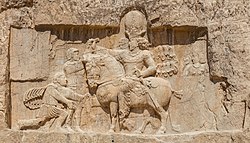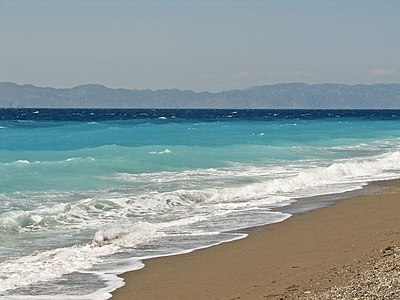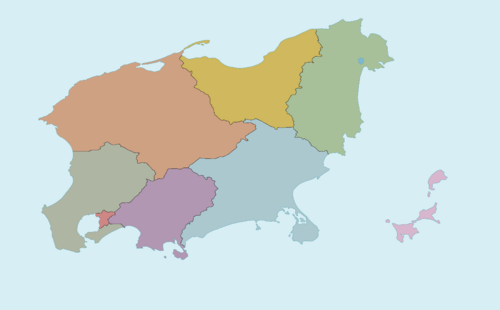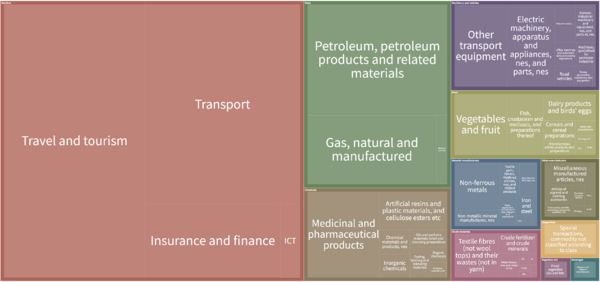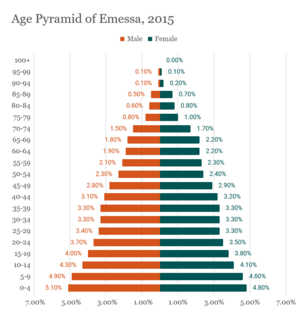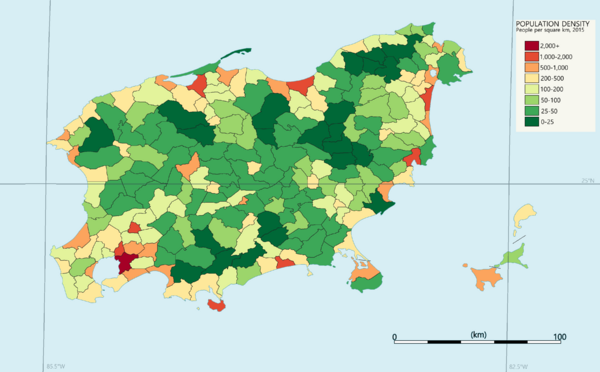Emessa
This article is incomplete because it is pending further input from participants, or it is a work-in-progress by one author. Please comment on this article's talk page to share your input, comments and questions. Note: To contribute to this article, you may need to seek help from the author(s) of this page. |
Republic of Emessa Repubblika ta' Imisa | |
|---|---|
Motto: Viribus Unitis "With United Forces" | |
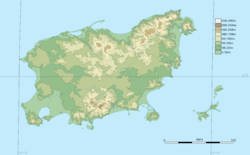 | |
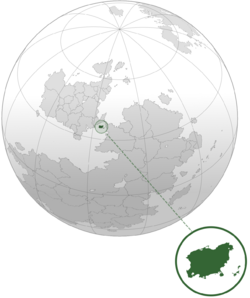 | |
| Capital and largest city | Himera |
| Official languages | Emessan |
| Recognised national languages | Atudite |
| Recognised regional languages | |
| Demonym(s) | Emessan |
| Government | Unitary presidential republic |
• President | Pawlu Vella |
• Vice-President | Vincenzo Ellul |
| Senate | |
| Chamber of Deputies | |
| Establishment | |
• Colonisation by Etruria | 1843 |
• Independence Wars | 1943-1946 |
• Emessan Independence | 1949 |
| Area | |
• | 22,487 km2 (8,682 sq mi) |
• Water (%) | 3.1 |
| Population | |
• Estimate | 5,681,900 |
• 2015 census | |
• Density | 247.8/km2 (641.8/sq mi) |
| GDP (PPP) | 2020 estimate |
• Total | |
• Per capita | |
| GDP (nominal) | 2020 estimate |
• Total | |
• Per capita | |
| Gini (2020) | medium |
| HDI (2020) | very high |
| Currency | Emessan lira (EML) |
| Date format | dd.mm.yyyy |
| Driving side | right |
| Internet TLD | .em |
Emessa (/ˈɛməsə/ E-mə-sə, officially the Rebublic of Emessa (Emessan: Repubblika ta' Imisa [rɛˈpʊbːlɪkɐ tɐ ˈɑmɑsˤɾ]) is a transcontinental country in the Solarian Sea, halfway between Southeast Euclea and Northwest Coius. It lies 94 km (58 mi) southeast of Paretia, 100 km (62 mi) west of Tsabara and 179 km (111 mi) east of Etruria. Emessa's location at the crossroads of the Euclean and Coian continents has shaped its rich history and shaped a national identity of religious and ethnic diversity. The official language is Emessan, a language related to Rahelian and Atudite, yet distinct due to its heavily solaricized traits.
Emessa has been continuously inhabited since the Paleolithic age. Owing to their strategic location in the middle of the Solarian Sea, the islands have been contested and ruled by a succession of powers, from the Nimene Civilisation in the Late Bronze Age to foreign empires, such as the Atudites, Piraeans, Solarians, Arsanids, Crusaders, and, more recently, Etruria and Gaullica. As a result, Emessa is home to a diverse mix of cultures and influences, with many archaeological and historical sites of differing traditions. Historically, the region has been controlled by a mix of Tribunals and merchant city-states, with the regional power structure in the Middle Ages being largely derived from late Solarian administration, instead of feudal power dynamics more common in Euclea.
|Etrurian presence in the archipelago began in 1378, with the conquest of the port city of Nineve by the thalassocratic Republic of Accadia. This lead to increased influence of Etrurian maritime republics in the Bay of Povelia, with various other ports becoming afilliated to such republics, notably the Republic of Accadia, the Republic of Amelia and Povelia. With the War of the Amelian League in 1450, Povelia gained significant concessions in the island, with near-absolute hegemony in Emessa's trading ports. To secure this position, Povelia turned Himera into a large fortified trading hub directly under its control, while influencing the various Emessan Tribunals. This influence was disputed with various Rahelian sheikhdoms and, later, Crusading States predominantly of Gaullican sponsorship. Etrurian rule of Emessa formally began in 1814, with the conquest of Himera and the eventual complete control of the island in 1843. The islands saw fighting during the Battle of Emessa in the Great War and again in the Solarian War, also called War of Independence in the country. Emessa became a joint trust territory, and achieved independence in 1949.
Today, Emessa is a parliamentary democracy with confessionalist characteristics, with most parties representing either of the islands' religious communities: Sotirianity, Irfan, and Atudism. Despite periods of troubles, the country has remained fairly calm and prosperous, with a upper middle income economy driven by the tertiary sector, notably tourism and banking, and a high human development index. Emessa is a member of the Community of Nations, the Aurean Forum, the International Council for Democracy, the International Trade Organisation, and the Global Institute for Fiscal Affairs. Historically maintaining a policy of armed neutrality, the country has nonetheless moved closer to the Euclean Community since the Alban War, with accession negotiations being underway since 2012.
History
Pre-Historic and Ancient Emessa
Main Articles: Nimene Civilization
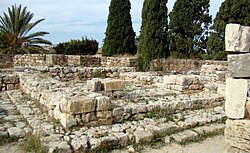
Hunter-gatherer societies settled the island as early as 9000 BC, with ancient water wells being discovered in the vicinity of Beni Taghit, and multiple fossilized footprints towards the islands interior. The earliest Village Community was discovered as early as 7900 BC. By 2000 BC, Emessa was the birthplace of one of Euclea's oldest advanced civilizations, the Nimenes. Nimene civilization was mainly centered around walled settlements, the most preserved of which is the Azkart Site, where multiple ceramics and a yet to be deciphered written script were found.
Major copper deposits, as well as exotic textiles and dyes had turned Emessa into a major commerce hub, turning several Nimene city states such as Tanit and Nineve into large ports around 1100 BC. In the same period, a new written alphabet was popularized among Nimenes in Emessa and beyond to facilitate trade. Independently, these city states later established various trading enclaves abroad, with various Nimene temple ruins and settlements being found in Etruria, Tsabara, Paretia and Piraea. Circa 800 BC, the Nimenes began a period of decline, with several of these overseas settlements being conquered by Piraeans and settlements in Emessa itself being overran by Piraeans. This brought significant cultural exchange to the island, with Piraean and Nimene city states coexisting for multiple centuries.
Solarian Period
With the usage of new metals such as iron, Emessa's position as a key supplier of copper in the area was no longer of great relevance. While impoverished, the various Emessan city states remained strategically located in various trade routes, making them valuable targets for the rising Solarian Republic. A coalition of Emessan City States, led by Adat Elishat and Attalus of Myrtos, succesfully repelled a Solarian invasion following the Battle of Cape Castor in 308 BC. This coalition was later defeated in 303 BC by General Flavius the Younger after a a three year long campaign.
During the centuries of Solarian rule, Emessa was heavily sotirianized, with much of its cultural composition being altered. Piraeans were priviledged along with the newly arrived Sotirians, while the Nimenes were cast aside politically. Emessa prospered as a major trading hub under Solaria, being central for the commerce networks linking Euclea and Coius. The keystone to this network was the rapidly growing port city of Himera, the largest city in the island. With the expansion of the Arasanid Dynasty in Coius, Emessa's position shifted from a trade node to a bastion. In 60 BC, Emessa was organized under the Cretician Reforms as a Praefectus Praetorio, under direct military administration. The island was heavily fortified and was the battleground of multiple wars between Solaria and the Arasanids. This period of dispute saw the island being intermittently controlled by Irfanic rulers, though the Solarians eventually reestablished their control. During these wars, Solarian Emperor TBD authorized the migration of various Atudite communities into Southern Emessa, in order to help bolster various defensive positions against the Arsanids, with the Atudite Soldiers being renowned for their victory and resilience in the 8 year long Siege of Devara.
Middle Ages
Main Articles: Emessan Tribunals
With the fall of the Solarian Empire in 426 AD, Emessa quickly fell under control of Irfanic Kingdoms to the south, following a series of wars of conquest. This led to the creation of the short lived Saramid Sheikhdom, which ruled Emessa in its entirety from 435 AD to 458 AD, with succession issues causing the splinter of the Sheikhdom into various smaller states, who managed to solidify their power primarily in southeastern Emessa. While these Irfanic rulers sought to convert those willing, they still ruled over a majority Sotirian population, with these petty sheikhdoms being notably tolerant, employing numerous Atudites and Sotirians in state duties. Despite this, Irfanic rule struggled primarily in the heavily populated, militarized and sotirian west. Emessa was fully reconquered by sotirians in 514, with the Verliquoian Empire establishing control that would endure until 914 AD.
With the Collapse of the Verliquoians, Emessa was under control by a collection of Petty Kingdoms. These kingdoms, also known as Tribunals, inheriting tradition primarily from the Solarian Empire, differed significantly in organization compared to its continental Euclean feudal counterparts. Such tribunals were distinguished by a lack of land inheritance on behalf of the ruler, with it instead being appointed by a council of elders. The Tribune acted as a central ruler and arbiter of laws, under the approval of the council. Emessa was divided under 4 Tribunals, of which the most notable was Pretoriana (Emessan: Tribuna Pretorjana), centered around Himera. These Tribunals were backed militarily by various mercenaries and citizen militias, with several mercenaries having achieved significant political prevalence, as councillors or Tribunes.
- Irfanic Conquest of the southeast
- Etrurian Maritime Presence
- Wars of Reconquest
Early Modern Period
- Full Irfanic control of the island
- Colonization by Etruria
Modern Period
Emessa was fully incorporated as a state of the Etrurian Second Republic in the 26th of June 1888, following an extended period of civil unrest in the island both by the unrepresented irfanic and atudite demographics and also by the ruling etrurianized sotirian elite. This unrest was intensified with Prime Minister Girolamo Galba's policies, with the nationwide capital shortages and debt crisis having a significant toll on Emessa's economy. Emessa's ruling elite became increasingly radicalized, with both separatist and revolutionary tendencies. The San Sepulchro Revolution was accompanied by the Mars Coup in Himera, with the Povelia appointed colonial governor decapitated following mass riots in the city. The brief First Emessene Republic was proclaimed shortly after, with popular support primarily among lower class workers and non-sotirian emessans, both heavily alienated by the colonial administration. The drafting of the new constitution in Etruria and promised reforms caused the Emessan elite to backstep from the newly proclaimed republic, facilitating the landing of Etrurian forces back into the island weeks after the unilateral proclamation of independence and thus causing the island to revert back to Etrurian control. The newly formed Etrurian Second Republic's democratic and administrative reforms guaranteed Emessa full statehood, though this arrangement heavily favoured the urban sotirian elite, with atudites and especially irfanic groups in the east still being largely alienated from political representativity.

While statehood thawed the separatist sentiment among the capitalist elite, the spirit of the short-lived Emessene Republic remained amongst the lower strata, while also gaining particular favour in the Emessan Intelligentsia. The Euclo-Coian Transition Zone concept published by Hugues Subercaseaux gained particular leverage amongst the intellectuals, redefining Emessan nationalist theory as a whole. This was particularly true with the publication of Euclea's Fulcrum: The Transition Zone in the Emessan Language in 1893. While the concept was initially a mainly Gaullican interpretation on the geostrategic importance of control of the Aurean Straits, the Alban Archipelago and predominantly Tsabara, Emessan publications ressignified the concept of the Transition Zone in more cultural terms, establishing a new Emessan identity primarily with the ressignification of the transition zone concept to cultural terms. The Transition Zone theory and its influenced publications were heavily censored by Etruria.
- Emessan participation in the Great War
- Solarian Wars and Independence
- Government of National Salvation
- Democracy
Geography
Emessa is considered a discontiguous transcontinental country, with the island of Emessa and the Alban Archipelago being part of the Euclean and Coian continents, respectively. Emessa is the largest island in the Solarian Sea, measuring 21826 square kilometers. The island is approximately 230km long from end to end and 120km at its widest. Emessa is located 100km from Paretia at its closest point, 124km away from Tsabara, and 179km away from Etruria. The physical relief of Emessa is defined by the Sannat Mountainsto the north, a mountain range whose highest point is Mount Kolonna at 1930m. The country's largest peak is Mount Qalb, an inactive volcano 2980m tall. The volcano's last eruption was in 480 AD. in Emessa's geology is comprised primarily of limestone formations, especially in its northern coast.
Emessa features a primarily mediterranean climate, with mild humid winters and dry warm summers. Snowfall occurs in the Sannat mountains during winter. The country is among the warmest countries of Euclea, with average temperatures of 26 °C during the day and 15 °C during the night. Sunshine hours average at 3440 hours of sunshine a year, being among the countries with the most sunshine in Euclea. The country has chronic water supply issues, with most of Emessa's water supply originating from rain water. As a result, the country has been investing heavily in dessalination plants.
Politics
Government
Between 1959 and 1984, Emessa was governed by an authoritarian regime in the form of the Government of National Salvation, following a military coup. Since the collapse of the regime, Emessa is a Unitary presidential republic. Executive power is held by president, who is both Head of state and Head of government. Legislative power is conducted by a bicameral parliament, with the Chamber of Deputies as its lower house and the Senate as the upper house. While the lower house follows a more conventional proportional representation system, the Senate's 63 seats are divided in thirds, with an equal number of Sotirian, Irfanic and Atudite seats. The Judiciary is enforced by the Supreme Court, responsible for reviewing and interpreting laws, as well as applying law in the name of the state.
Every Emessan citizen above the age of 16 is allowed to vote, being categorized into three communities, or recognized minority groups. While this system has been criticized by secularists and among the recently growing irreligious demographic, communities are defined as "demographic groups with common religious belief or traditional customs". This classification is done as part of the census, with citizens identifying with the group they affiliate with the closest. Since the 1984 constitution, all groups share the legal system in its entirety, with this classification being mostly held for the Senate's voting system.
Emessa's confessionalist characteristics have dwindled since the end of the dictatorship, with there being no enforced proportionality in the country's military, civil service and law enforcement. The two primary institutions where proportionality is still upheld are the Senate and the country's Supreme Court. Since the Senate must approve laws passed by the Chamber of Deputies, this means that laws must always reach at least a simple majority between the primary groups of Emessa, with no religious community being able to pass laws on its own self interest.
Foreign Relations
Emessa's foreign policy is based on non-alignment and armed neutrality. This is upheld by a strong national security policy, combined with close economic connections and open policy towards trade among multiple blocs. Emessa's last war was the 1982 Alban War, where the country was invaded by Tsabara, which remains Emessa's primary geopolitical concern, especially following the advent of the Tsabaran Civil War.
Economically, Emessa has close ties with the EC, with which it has several trade agreements. In 2014, Emessa started its application process towards joining the EC as a full member, though opting out of the ECDTO. Despite its close ties with the EC, Emessa also has cordial relations with Zorasan. Emessa has a notable presence in the CN's Peacekeeping missions, primarily in Bahia,with the country's plurality allowing it to be present in various areas of the world while still sharing some form of bond with the local populations.
Armed Forces
Main Articles: Emessan Defence Forces
Despite the country's small size, Emessa has a comparably large military. The Emessan Defence Forces are primarily oriented towards detering attack to its territory and partaking in peacekeeping missions. The Armed Forces are divided into the Army, Navy and Air Force. Males reaching the age of 18 are conscripted, with military service being optional for females. Following a year of mandatory service, conscripts join reserve duty, doing up to three weeks of training yearly every year until the age of 40. Emessa is one of the countries with the largest percentages of citizen's with military training, owing to this large number of conscripted soldiers. The military is subject to the Ministry of Defence and the Defence General Staff, with the President being commander-in-chief of the armed forces.
Since the country's independence, Emessa adopted a policy of neutrality, with the country not participating in any alliance. The Emessan army was founded with the end of the CN Mandate in Emessa, supplied primarily by surplus equipment of the Grand Alliance and former Etrurian materiel. The 1959 coup and the subsequent Government of National Salvation resulted in an increased militarization of the country, both as means of guaranteeing internal stability and repressing political dissent, as well as dissuassion against external threats. Its primary security concern was the Socialist Republic of Tsabara, which disputed sovereignty of the Alban Archipelago. This dispute culminated in the 1982 Alban War, of which Emessa emerged as the victor with extensive foreign aid of materiel. The fall of the socialist regime in Tsabara in 1986 and the economic crisis in the 1980s have since resulted in a reduction of military expenditure.
Emessa spent 4 Billion Euclo in defence in 2021, corresponding to 3% of its GDP. Defence expenditure is surging upwards due to the Tsabaran Civil War. Despite this relatively low budget, Emessa fields a comparably large air force and navy, mostly due to foreign subsidies and aid. Emessa's military has undergone notable modernization efforts since the 2010s, particularly in the navy. A large majority of Emessa's military equipment is imported from ECDTO and Samorspi members, with Zorasan also being a supplier. Domestic production is limited to maintenance, upgrades and refits of imported vehicles and small arms, with Emessa's Shipbuilding industry being the only exception. Emessa locally builds many of its warships, with many of them also being local designs, which it also exports.
Internal Subdivisions
| A map of the Regions of Emessa. |
Emessa is divided in 8 first level divisions, named tribunals, two of which enjoy special autonomies and status, in a form of devolution. Other geographical divisions such as macro-regions exist, though they hold no political power or representation.
| Coat of Arms | Tribunal | Governor | Capital | Population |
|---|---|---|---|---|

|
Himera (HM) | Marija Grech | Himera | 1,108,670 |
| Pretorjana-Nord (PN) | Federika Granieri | Marsala | 953,498 | |
| Pretorjana-Nofsinhar (PE) | Lawrence Attard | Mosta | 734,091 | |
| Perla (PL) | Alwiġi Bastjan | Nineve | 481,507 | |
| Tramuntana (TM) | Ibrahim Għamos | Qom | 763,605 | |
| Adata (AD) | Danjel Tumas | Tanit | 935,724 | |
| Marċi (MR) | Żakkarija Rokku | Beni Taghit | 717,265 | |

|
Alba (AB) | Ċeċilija de la Perriere | Kasserine | 157,540 |
Each tribunal is divided into municipalities or boroughs in the case of Himera, which form Emessa's second level subdivisions. According to the Emessan Constitution, each Tribunal has limited levels of autonomy within its defined borders, with its level of autonomy defined by a regional constitution. All tribunals with the exception of Himera and Alba are labeled "Regions with ordinary statute", having a unicameral regional council with residual legislative powers and an elected governor. These tribunals have little financial and political economy, being responsible for running region based services such as healthcare, high schools and local infrastructure.
The Himeran Tribunal is categorized as a Metropolitan Tribune, subdivided into boroughs and with a regional council featuring increased legislative powers. Unlike other tribunals, the Governor is appointed by the president, which has been an increasingly controversial point. The Alban Archipelago is another special tribunal, featuring higher levels of devolution and autonomy, with its own bicameral legislature and significantly different regional constitution.
Economy
According to the ITO, Emessa nominal GDP is the 53 largest in the world at 135 billion Euclo, and 205 billion Euclo by purchasing power parity. Regarding per capita income, Emessa has the 23rd highest nominal GDP per capita, at 23,332 Euclo and 36,103 Euclo when adjusted by purchasing power parity. The Emessan economy is classified as a high complexity high-income economy. It is considered to be a Mixed Economy, with several state owned companies primarily in the petrochemical and energy sectors.
Emessa historically had abundant quantities of tin in cassiterite deposits, which have reduced in importance historically due to their depletion. Major natural resources found in emessa today are bauxite, sulfur and abundant offshore natural gas deposits. Emessa's exports reached 35 billion Euclo in 2021, with refined petrochemical products, natural gas, pharmaceutical products, chemicals, industrial electronics, machinery, agricultural goods and naval vessels being some of its leading exported products. Emessa is a major exporter of refined petrochemical goods, such as fuels, plastics and organic chemicals to the international market, with its refineries being among the most important in southern Euclea. The petrochemical sector is mainly dominated by KNZ, a state owned petroleum company that partakes in petroleum extraction and refining. Since 1986, the company no longer has a monopoly in petroleum extraction and refining in Emessan territory, with several reserves being operated by private companies. Most of Emessa's Petroleum fields are predominantly composed by non-associated gaseous hydrocarbons, with natural gas being the country's primary crude export in the energy sector.
Emessa holds 25.6 billion Euclo in foreign reserves, though these reserves have been reducing as of 2020 due to increased expenditure motivated by the Tsabaran Crisis. The country's national debt is a growing concern, with the debt of 112 billion Euclo representing 82.9% of its GDP and increasing since 2020.
The service sector is the largest sector of the economy at 81%, with industry and Agriculture comprising 15% and 4% of the economy, respectively. Tourism is a major factor in the Emessan economy, being responsible for over 25% of the national GDP in 2020. Merchant shipping is another major sector, with Emessa having the largest total shipping capacity in the world due to the country's ship registration incentives. The main industrial sectors of the emessan economy are the shipbuilding and petrochemical sectors.
Much of the economic activity and wealth is concentrated in Himera, Emessa's most populous and wealthiest city. Himera's nominal GDP per capita is more than double the national value at 51,104 Euclos, holding much of the country's financial sector and tourism. Himera has reduced in economic growth since the 2005 crisis, with other cities growing at faster rates in population and economic growth due to Himera's high unemployment rates, living costs and crime issues. The fastest growing region economically is Adata, with the Imran-Tueffieha conurbation being a hub of development in information technology. Unemployment in the country as a whole is at 6.4% and 18.7% for youth between 15 and 24 years old. This has been a growing concern due to the recent Tsabaran Refugee Crisis, which has increased unemployment rates and strained the Emessan economy due to relief efforts.
Many companies have regional headquarters in Emessa due to its fiscal incentives and position near large markets in in Rahelia. Since 2010, the country has incentivized startup incubation policies which have made it the 5th country with the most startups despite its small size, focusing particularly in information technology and electronics in hubs such as Imran-Tueffieha.
Work weeks in Emessa differ for those in Euclea, primarily due to atudite customs and observance of Shabbat. Although this is not enforced and has many exceptions, particularly in non-atudite areas of Emessa, it is customary for the work week to be five days from Sunday to Thursday.
Agriculture

Agriculture in Emessa is primarily family-operated, with rural properties averaging 8 hectares in size. The country's urbanization has however increased the consolidation of larger rural properties under companies since the 2005 crisis, with 9% of Emessan rural areas being owned by large landowners in 2021 compared to 2% in 2005. Not including forestry, agricultural surface area is predominantly occupied by grain fields (34.5%), pastures (20.1%), horticulture (15.4%), feed grains (10.1%), followed by vineyards (6.7%), olive orchards (6.1%), citrus orchards (4.9%), and sugar beets (2.2%). Wheat is the major grain produced in Emessa, with Maize corn and soybeans also being of large economic relevance, the latter mainly used for feeding livestock and export into the international market.
Livestock predominantly consists of sheep, pork and goat. Emessa is also a major exporter of horses, predominantly used for sport and labour. The fishing industry in Emessa is also a major agricultural sector, both in capture and aquaculture, with 167 thousand tons of fish captured and 181 thousand tons produced from aquaculture. Emessan primary seafood products are blue water fish, crusataceans and molluscs.
Emessa's most valuable agricultural products are its local wines, olive oils, fruit varieties (predominantly citrus fruits such as lemons, oranges and kiwifruits), artichokes and local tomato varieties. Emessan wine varieties are predominantly distinguished by the nature of the island's volcanic soil, with many regional wine types. Another high value sector is Emessan dairy, with the country's goat cheese varieties being among the most premium types in the world.
Infrastructure
Science and technology
Energy
Technology
Tourism
Demographics
The population of Emessa is estimated to be around 5.85 million in 2022, with the number of citizens estimated at around 5.59 million (June 2021). The last census was conducted in 2015, with a population of 5,128,210 inhabitants, of which 4,973,326 were citizens. Since the 2000s the country has had a positive net migration rate, predominantly composed of older age retiring Eucleans due to the country's financial policies and low cost of living. According to the Transcontinental Demographics Institute, approximately 240,000 immigrants live in Emessa, of which the majority is Etrurian, followed by Weranian, Paretian, Gaullican and Tsabaran migrants. The Emessan identity is subdivided into three major groups, characterized primarily by religious customs. The most numerous group are the Sotirian Emessans, followed by Irfanic Emessans and Atudite Emessans. These identities are distinct from other ethnic groups which share such religious practice such as the Tsabaran atudites, although they share many customs. The primary language in the country is Emessan, which shares official status with the Atudite language.
Emessa has suffered significant migration waves, both of emigration and immigration. Following the country's independence in 1949, approx. 100,000 people emigrated from the country from 1950-1955, mainly to Etruria. A second period of emmigration happened between 1968 and 1980, with an estimated number of 300,000 Emessans leaving the country due to the intensification of domestic authoritarian policies taken by the Triumvirate. Large Emessan communities exist in Etruria, Eldmark, Gaullica and Paretia, with approximately 2,320,000 people of Emessans residing outside Emessa in 2022. Eldmark is the country with the largest Emessan diaspora community in the Asterias, with over 400,000 people of Emessan origin. The majority of these Emessans came in the 1970s, during the triumvirate period.
As of 2020, Emessa has became a country sought by Tsabaran refugees and Asylum seekers due to the civil war in the country. The number of refugees has recently increased due to the intensification of the war, with approximately 60,000 refugees residing in Emessa by late 2021, and an estimated 80,000 by march 2022. These refugees are predominantly of Atudite origin.
Religion
Religious distribution in Emessa
Emessa is among the most religiously plural countries in the world, with 3 major religious groups. Historically, Emessa had a Sotirian majority according to the Etrurian Census data conducted during its period of control of the island. However, Emessan independence and population growth in the country's east resulted in no religion having a majority of the population. Among the sotirian community in Emessa, 82% identifies as catholic, while 16% follows the eastern rite and 2% are amendist. Catholicism was heavily sponsored by the Etrurian government until the country's independence in 1949, having supplanted the previously traditional eastern rites in the majority of the country.
The Irfani population in Emessa is predominant in the country's east, with the religion being present in the island since the Arasanid Empire. The Irfanic community in Emessa is subdivided within 6 recognized religious sects, differing in practice and interpretation of the various religious acts of worship and articles of faith. The Irfani community in Emessa is particularly secularized when compared to other Coian countries, with many self-identifying as "traditionally Irfani" but not regularly practicing its religious rites.
Atudites in Emessa share many similarities with those in Tsabara, being also divided as Hiloni (secular),Masorti (traditional), Dati (religious) and Haredi (ultra-Orthodox). Sponsored by the Triumvirate's national policy and campaigns, 59% of Atudite Emessans identify as Hiloni, whereas 24% identify as Masorti, 11% as Dati and 6% as Haredi. While the seculars form the majority, it has been noted that the growth rates of Haredim are much larger than the other groups, with ultra-Orthodox Atudites also very rarely intermarrying with other Atutide groups. Contrary to the other communities, Emessan Atudites, particularly of more religious backgrounds, also use the Atudite language in daily life, often being billingual with Emessan.
A distinct feature of the Emessan Census is the lack of the "irreligious" option, with many instead identifying as 'Other'. While there are many minority unrecognized religious communities in Emessa, often limited to some thousand members, this section of the Emessan census has increased from 2% in 2010 to 4%. This is interpreted as an increase in Atheism, although many irreligious still self-identify as one of the three religious groups due to the nature of the religious census impacting the voting system of the country's senate.
Language
The Emessan language is derived from late medieval insular Rahelian, influenced by Etrurian dialects spoken by an urban elite in the port cities. It is a rahelic language, though due to the significant solarization of the language, it has since diverged and is completely uninteligible to other rahelic languages. Emessan is written mainly in the solarian script since its earliest records, dated to the 14th century. The language is spoken as first or only language by the majority of the population from all three religious groups, and is the main language spoken in the country. The Atudite language is extensively utilized in conjunction with Emessan by the country's Atudite population, enjoying co-official status in the country. Especially amongst the more religioust ultra-orthodox communities, who are often in isolated communities, Atudite is used as the primary language.
Several other languages are regionally relevant, with Gaullican being a regionally recognized language in the Alban Archipelago, and certain municipalities having Tethian and Piraean as locally recognized minority languages. Recent immigration has increased the number of peoples whose native language is not Emessan, with Rahelian speakers being the largest of such groups, with over 100,000 first language rahelian speakers in the country.
Many Emessans speak a second or third language, with Atudite and Pardarian being amongst the most common, due to both languages religious relevance to the Atudite and Irfani communities, respectively. Gaullican and Etrurian are also widely spoken, with Gaullican being part of the national curriculum. Etrurian is mostly spoken by older generations, with the number of speakers dwindling over time.
Largest cities
Largest cities or towns in Emessa
2015 census | |||||||||
|---|---|---|---|---|---|---|---|---|---|
| Rank | Region | Pop. | Rank | Region | Pop. | ||||
 Himera  Marsala |
1 | Himera | Himera | 1,108,670 | 11 | Nineve | Perla | 71,305 |  Qom  Imran |
| 2 | Marsala | Pretoriana-Nord | 394,622 | 12 | Kasserine | Alba | 66,504 | ||
| 3 | Qom | Tramuntana | 259,103 | 13 | Kastri | Pretoriana-Nord | 43,584 | ||
| 4 | Imran | Adata | 199,510 | 14 | Flavjana | Perla | 30,202 | ||
| 5 | Scilla | Pretoriana-Nofsinhar | 174,599 | 15 | Azkart | Tramontana | 21,703 | ||
| 6 | Tanit | Marċi | 120,364 | 16 | Manikata | Pretoriana-Nord | 15,292 | ||
| 7 | Beni Taghit | Marċi | 108,309 | 17 | Mgarr | Tramontana | 12,799 | ||
| 8 | Tueffieha | Adata | 104,967 | 18 | Paceville | Alba | 11,036 | ||
| 9 | Mosta | Pretoriana-Nofsinhar | 97,613 | 19 | Dwejra | Adata | 10,883 | ||
| 10 | Dawwar | Marċi | 78,592 | 20 | San Pawl | Pretoriana-Nofsinhar | 10,246 | ||
Education
Healthcare
Culture
Art
Architecture
Cuisine
Due to its multiple demographic groups and historical influence by different civilizations, Emessa's cuisine fuses several culinary forms. Emessan food is primarily developed from Rahelian, Etrurian and, to lesser extents, Gaullican and Piraean influences. Emessan cuisine is based on a large variety of vegetables and Seafood, as well as mutton and poultry. Following Emessan independence in 1949, cuisine was considered one of the primary forms of establishing a joint cultural folklore for Emessa, with there being a continuous state-sponsored effort to present, revive and value traditional and modern Emessan culinary practice.
Emessa, like its other neighbors, largely follows a distinctly Mediterranean basis to its ingredients and forms of cuisine, generally with few core ingredients augmented by a large variety of spices. The discovery of the Asterias and Etrurian colonization of the islands revolutionized dietary habits and local agriculture, bringing with it many of Emessa's staple items, particularly tomatoes, of which Emessa is a major exporter of due to the excellent quality of its volcanic soil. Some frequenttly used ingredients are olives, tomatoes, carrots, cucumbers, lettuce, beans, asparagus, peas, lentils, lamb, poultry, octopus, sea bass, squid, cauliflower, beets, pistachio, lemon, orange, pears, figs and grapes. Emessan recipees are usually not elaborate, generally requiring few processes of preparation and focusing on fresh ingredients. Staple aspects of Emessan cuisine are the Saj, a typical reversible pan used to cook traditional dishes of various kinds, and Stone ovens, which have been resurfacing in popularity, especially in restaurants.
Emessan ingredients and products such as wine, olive oil, tomatoes, Cheese, citric fruits and artichokes are highly valued in the export market, not only due to the favourable climate and traditional cultivation, but also the Basalt-heavy volcanic soil, which not only results in high fertility for wines and tomatoes in the country's northeast, but also gives them a distinctly unique flavour.
Some of Emessa's staple foods are Lahmacun, the country's national dish, Chorba, kebab, Shakshouka, Gözleme and Fideuà. The Alban Archipelago also features distinct cuisine characteristics, both due to its heavy reliance on fish products and also its increased Gaullican influence. The main regional dishes of the alban islands are Baccala au Blaise, derived from codfish brought by Gaullican sailors that garrisoned the islands, and Tapenada, a spread done with olives and anchovies.
The country has a large street food culture in its major cities, with Himeran vendors also being a tourist attractio. The country is famous for its kebab, a street food ubiquitous in Emessa that has seen growing popularity across the entire world. Other common street foods are sandwiches, local varieties of falafel and shawarma and Kafta. Satrian dishes such as curry are also very popular in Emessa, brought in colonial Etrurian times.



